Laser safety clearly, or why you should not look into the laser beam
Today's article will be somewhat boring, because it raises issues that usually no one likes to discuss. And it will focus on the main, most important issues related to TB for working with lasers. I will try to tell about this unpleasant, but very important topic with a minimum of tedious letters and numbers that people like to cite in various “reference books on safe operation rules”, having analyzed the main issues with the help of clear and accessible examples in the spirit of “what will happen if”. What danger does the laser have in it? Are all lasers equally dangerous? We'll figure out.
ATTENTION: This article may contain errors and inaccuracies, since I am not an expert in medical matters.
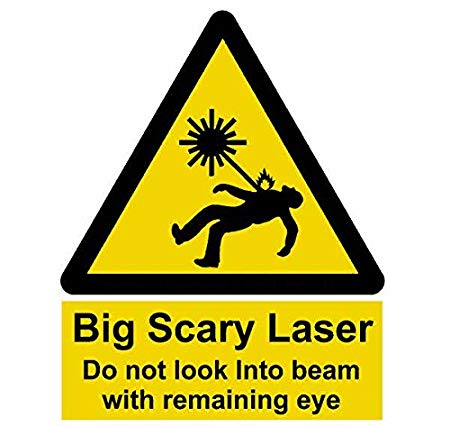
As is known, the main property of a laser is a very high directivity and monochromaticity of radiation, a significant power of the light flux is concentrated in a very thin beam. In turn, each of us is equipped with a very sensitive apparatus for the perception of light — with our eyes. The eyes, on the contrary, are designed to use the smallest levels of light intensity to provide their host with the necessary visual information. It is already becoming clear that the combination of a highly concentrated and powerful light beam with a sensitive visual organ is already poorly compatible, respectively, such a beam will be dangerous. This, in general, is obvious, if one cannot look at the Sun for more than a few seconds, then into a beam of a powerful laser that burns holes in paper — even more so. But not everything is so simple. The danger of laser radiation strongly depends on its nature (pulsed or continuous), power, wavelength. Also, very many installations based on gas or solid-state / liquid lamp-pumped lasers contain circuits and high-voltage components — transformers, radio tubes, switching arresters and thyratrons, powerful capacitors, which are a source of electrical danger. But I will not focus on them, a lot of literature has been written about electrical safety, and this is a topic that has become a bit tattered among testers. Here I will confine myself only to the consideration of the danger of optical only - which is directly transmitted by laser radiation. Also, very many installations based on gas or solid-state / liquid lamp-pumped lasers contain circuits and high-voltage components — transformers, radio tubes, switching arresters and thyratrons, powerful capacitors, which are a source of electrical danger. But I will not focus on them, a lot of literature has been written about electrical safety, and this is a topic that has become a bit tattered among testers. Here I will confine myself only to the consideration of the danger of optical only - which is directly transmitted by laser radiation. Also, very many installations based on gas or solid-state / liquid lamp-pumped lasers contain circuits and high-voltage components — transformers, radio tubes, switching arresters and thyratrons, powerful capacitors, which are a source of electrical danger. But I will not focus on them, a lot of literature has been written about electrical safety, and this is a topic that has become a bit tattered among testers. Here I will confine myself only to the consideration of the danger of optical only - which is directly transmitted by laser radiation. A lot of literature has been written about electrical safety, and this is a scathing topic among tesast builders. Here I will confine myself only to the consideration of the danger of optical only - which is directly transmitted by laser radiation. A lot of literature has been written about electrical safety, and this is a scathing topic among tesast builders. Here I will confine myself only to the consideration of the danger of optical only - which is directly transmitted by laser radiation.
When varying the parameters of the laser will also vary the mechanisms of damage to the eyes, which are described in detail in the specialized literature. The effects of laser radiation, regardless of its power, are described in the picture:

This data should not be taken as the ultimate truth, it is only the version of one of the books. The described effects can be combined in any ratios, depending on the other parameters - power and wavelength. Strictly speaking, the pulsed mode of the laser can be divided into two more - a pulsed mode of free generation and a pulsed mode with Q-switched. In the second case, the laser translates into so-called. “Giant pulse mode”, when all the energy accumulated during pumping from the working medium is emitted by a short (few tens of nanoseconds) pulse. The power per pulse at the same time reaches many tens and hundreds of megawatts with modest sub-joule energies. When exposed to a "giant impulse", the damage has primarily an explosive mechanism, since the heat generated by absorption cannot go anywhere in such a short time. Under the action of a pulse of free generation, damage proceeds more by a thermal mechanism, since heat partially discharges and disperses in the thickness of the absorbing layer, since the pulse has a lower peak power due to a relatively long duration (milliseconds).
Particularly characteristic is the role of wavelength, since the transparency of ocular media is not the same for different wavelengths. As a departure from the topic, I note that for X-ray or gamma radiation, it is considered that the biological effect does not depend on the wavelength, only the penetrating ability changes. And in general, in the specialized literature on issues of protection from X-rays are delayed only a few pages, while issues related to safety when working with laser radiation can devote entire sections. But back to the dependence of the effects of wavelength. Here we turn to another table from the same book. It describes the damage mechanisms depending on the wavelength, again without regard to power.

It is clear that the most obvious will be the danger of radiation of the visible range, since it is this that reaches the retina and is perceived by it. But if it is obvious - this does not mean that the most dangerous. The fact of the matter is that the beam of the visible range can be seen, and the blink reflex of the eye in this case works flawlessly, in some cases it can greatly reduce damage. While the beam from the near infrared range is already impossible to notice, but it also reaches the retina and there is no blink reflex. It is the retina that is the most sensitive part of the eye to damage, and most sadly - incapable of regeneration.
Thus, if the radiation mode and wavelength are known, the last, in fact, decisive factor remains - this is the radiation power. It is she who decides if your eyes burn under the beam completely, partially or not at all. Depending on the wavelength, only the magnitude of this power changes, if the beam is continuous, or the pulse energy, if the beam is pulsed.
It was by the radiation power that the separation of lasers into existing hazard classes was adopted. Consider them in more detail, looking at the site Sam's Laser FAQ. For convenience, a Russian translation from English is provided by moderator of the forum laserforum.ru Gall. And whoever finds a mistake in the picture is a good fellow.
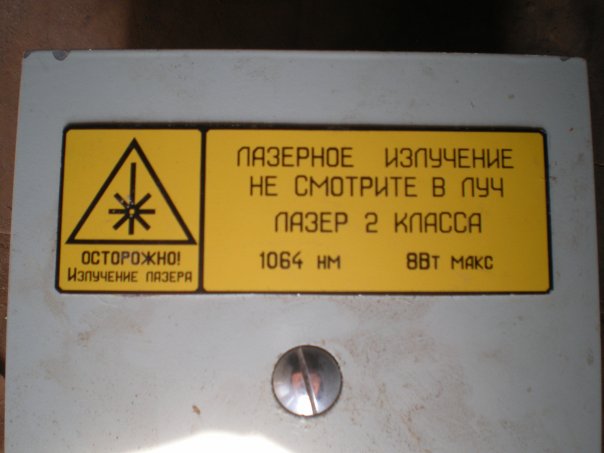
So, danger classes.
Quote:
• Class I laser products
There are no known biological threats. The radiation is closed from any possible viewing by a person, and the laser system has interlocks that do not allow the laser to be turned on in the open state. (Large laser printers, such as the DEC LPS-40, operate on 10 mW helium-neon lasers, which are class IIIb lasers, but the printer has interlocks to prevent any contact with the open laser beam, so the device does not present a biological hazard, although the laser itself belongs to class IIIb. This also applies to CD / DVD / Blu-ray players and small laser printers, as they are laser products of class I).
• Class II laser products
Output power up to 1 mW. Such lasers are not considered optically dangerous devices, as eye reflexes prevent any damage occurring. (For example, when a bright light enters the eye, the eyelid blinks automatically or the person turns his head so that the bright light disappears. This is called a reflex action or reaction time. Class II lasers do not cause damage to the eye during this time. Also, nobody wants to look at it for a longer time.) Warning signs (yellow) should be placed on the laser equipment. There are no known skin exposure hazards and no fire hazard.
• Class IIIa laser products
Output power from 1 mW to 5 mW. Such lasers can cause partial blindness under certain conditions and other eye damage. Products containing a class IIIb laser should have a laser indicator that indicates when the laser is operating. They must also have a “Danger” sign and a sign indicating the laser exit hole mounted on the laser and / or equipment. SHOULD install the power switch in the form of a key lock to prevent unauthorized use. There are no known skin and fire hazards.
• Laser products class IIIb
Output power from 5 mW to 500 mW. Such lasers are considered definitely a threat to vision, especially at high power, which WILL DAMAGE your eyes. Such lasers MUST have a key lock against unauthorized use, an indicator of the presence of laser radiation, a switch-on delay of 3 to 5 seconds after power is applied so that the operator can get out of the way of the beam, and a mechanical shutter that allows the beam to be blocked during use. The skin can be burned at high output power levels, and a short-term direction to some materials can lead to fire. (I saw a 250 mW argon laser igniting a piece of red paper in less than 2 seconds of exposure!) The red “DANGER” sign and the exit sign should MUST be placed on the laser.
• Class IV laser products.
Output power> 500 mW. These lasers MAY damage and damage the eyes. Capacity level IV class may ignite and ignite combustible materials in contact with, including burn skin and burn through clothing. Such laser products MUST have: A
key lock to prevent unauthorized use, locks to prevent the system from being used with covers removed, radiation indicators indicating that the laser is working, mechanical shutters to block the beam, and red "DANGER" ("DANGER") and The signs of the outlet, mounted on the laser.
The reflected beam must be considered as dangerous as the original beam. (And again, I saw a 1000 watt CO2 laser burning a hole in steel, so imagine what it would do to your eye!)
End of quote.
Note: Yes, my lasers are mainly classified as 4th hazard class, and do not contain many hardware protection measures, since only I deal with them. Therefore, I ask to refrain in the comments from the questions why there is no lock switch or covers with interlocks on my lasers. These requirements are primarily for commercially available installations.
Now let's see, so to speak, visually how an eye injury looks like by laser radiation. I have already mentioned that in search of new lasers and their components I visit various organizations. And once I visited the laser department of the local center for the treatment of eye diseases. In the course of communication with specialists, I wondered if there were injuries in their practice caused by laser radiation. The answer surprised me. The fact is that for more than 20 years of practice, laser injuries were only a few pieces. To my question, like so, if now every child has a laser pointer from 50 to 2000 mW, they only answered that there were no people with burns from the pointer. But there were a lot of people with solar, non-laser, burns of the retina. I was shown documents on the most remarkable laser injury - severe damage to the central fossa of the retina caused by a specularly reflected pulse from a laser rangefinder, built on a pulsed neodymium laser (Nd: YAG) working in the Q-switching mode. The pulse energy was, according to various estimates, from 20 to 100 mJ, with a pulse duration of the order of 20 ns. It was because of the modulation of the Q-factor that the damage was so severe - because at the focal point of the radiation there was an optical breakdown that caused a water hammer, which in turn led to a central retinal break and swelling of the latter together with hemophthalmia (vitreous hemorrhage). I was allowed to scan documents on the terms of their complete anonymization. Using optical coherent tomography, you can examine the retina in section, in different planes. It looked like a cut at the time of seeking medical assistance. There is a clear “hole” with the edges “bent outward” (in fact, it is edema).
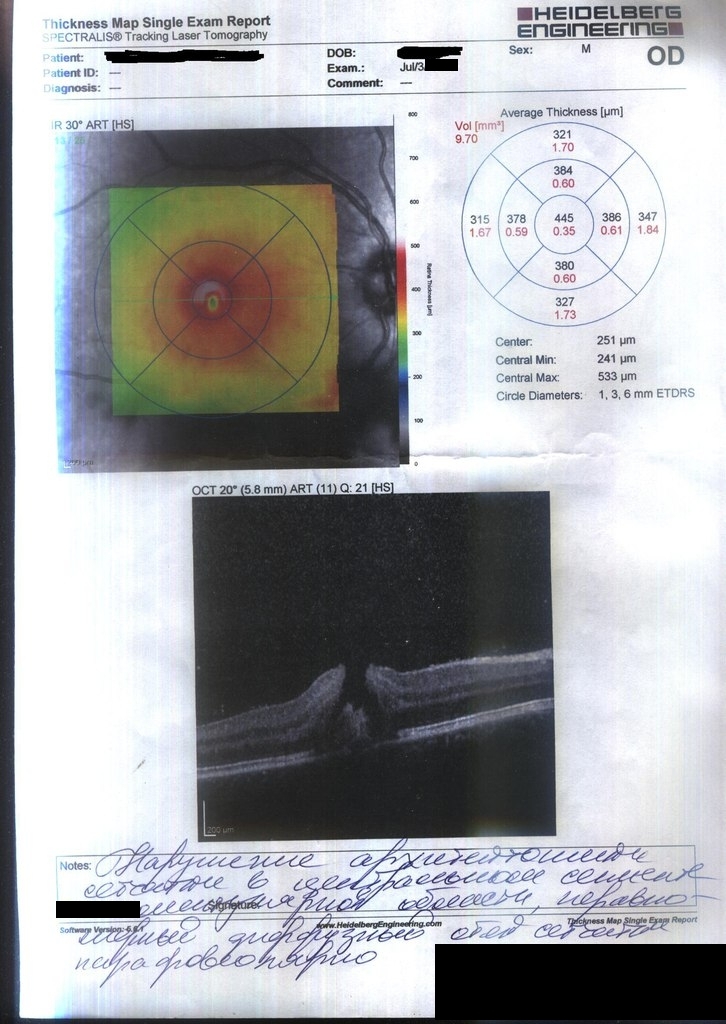
A larger plan:
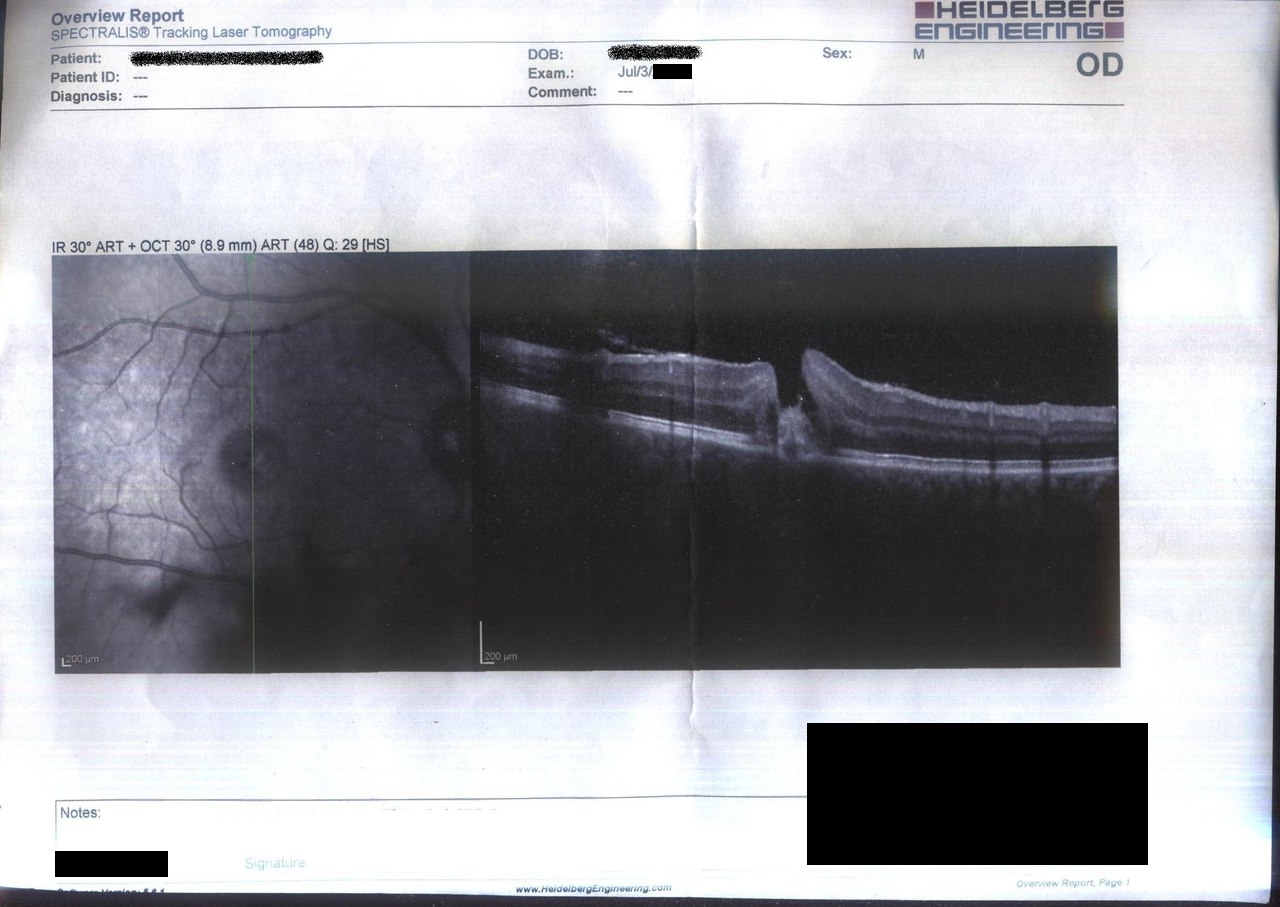
And in different planes:
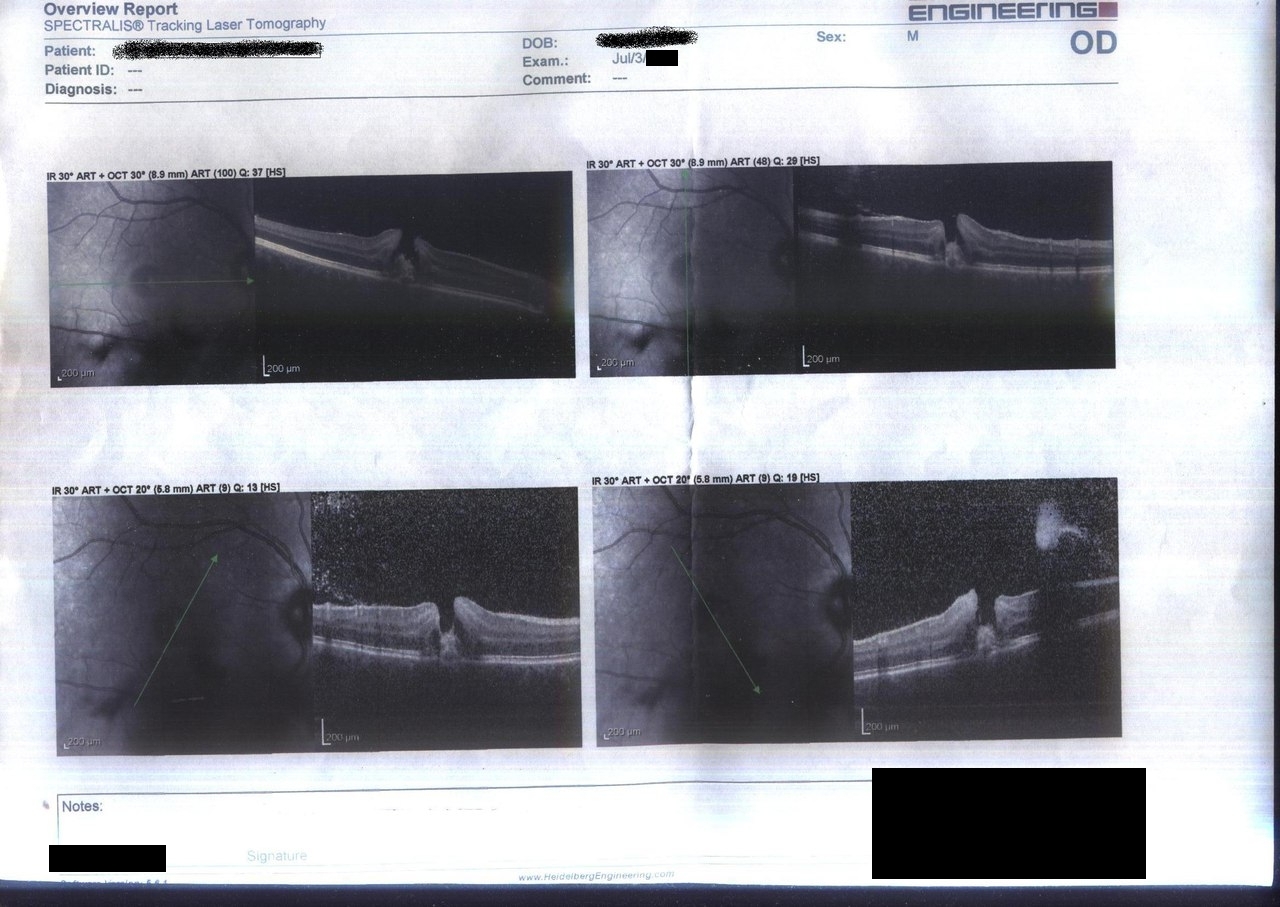
From the text of the documents provided to me, it became known that the course of treatment lasted 10 days, during which the question of the operation was decided, in case of retinal detachment. As a surgical intervention to eliminate a possible detachment and close the gap, pneumoretinopathy was suggested. Conservative treatment was aimed at resolving the edema and preventing the inflammatory process. In the course of the observation, several fundus photos were also taken, and at the end of the course, it was decided that the operation would not be necessary, since the gap closed on its own and was overgrown with scar tissue.
Photos of the fundus are placed in chronological order.

In a handful of the same documents lay another printout of optical coherence tomography after the end of treatment.
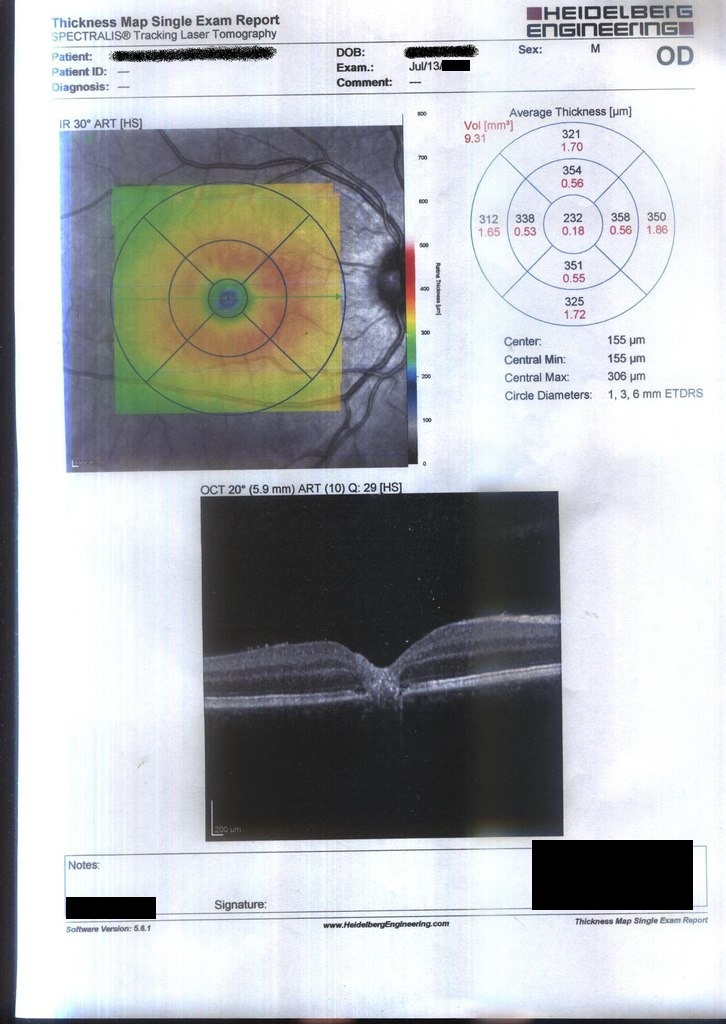
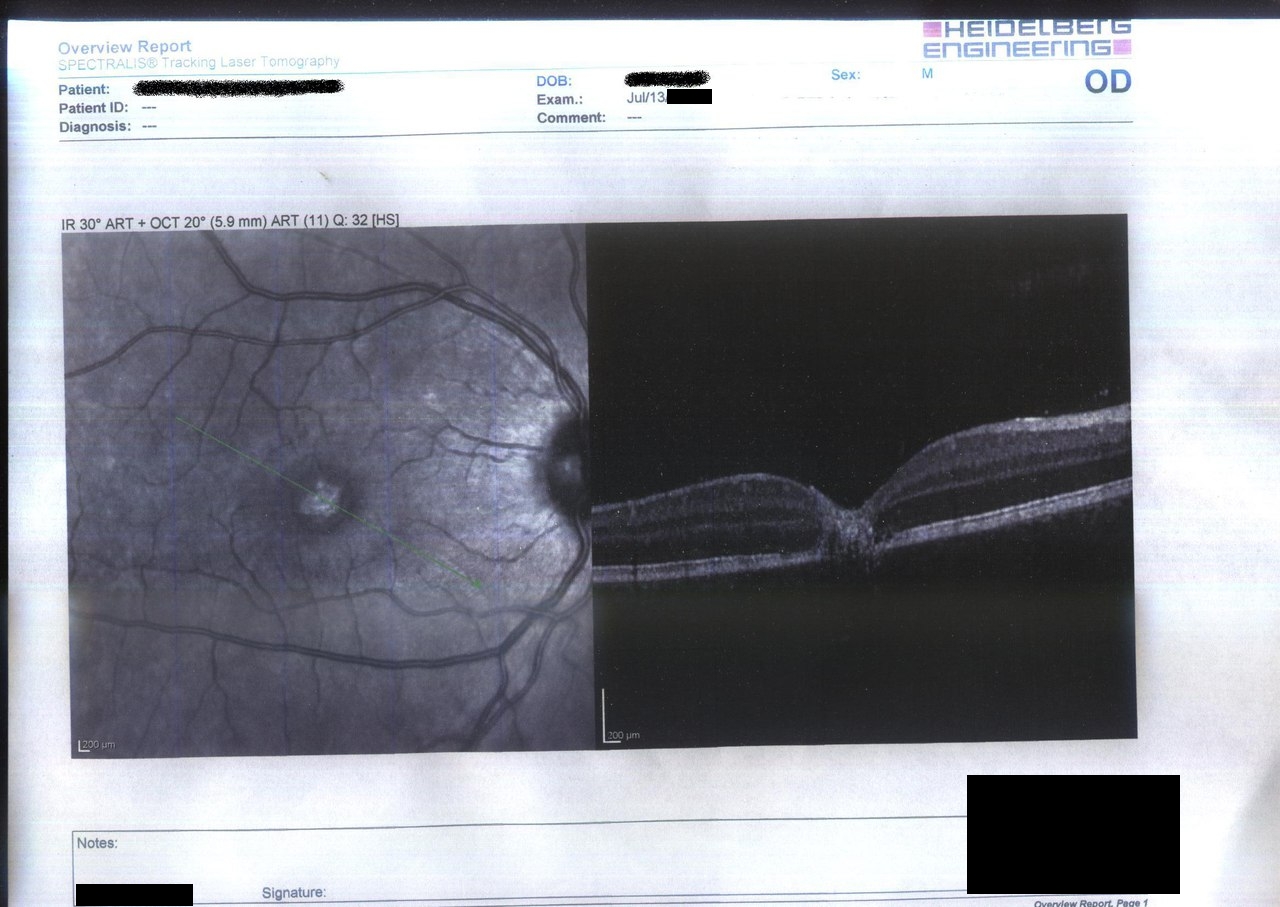
As you can see, the breakdown channel disappeared, and the edges of that place, which was the central fossa, took on smoother shapes. At the time of injury, the visual acuity on the table. Sivtseva was 0%, after the end of treatment, an improvement of up to 30% was achieved. To my question of how it is perceived subjectively, I was shown another picture, which clearly shows what a “central scotoma” is. This is a blind spot, from which just part of the image falls. The brain is able to “paint over” it to the color of the surrounding background, but no image details will be visible, since there is nothing to see - the light-sensitive cells in this place are destroyed. For this article, the picture is taken from Google. I was also told that in the presence of a second healthy eye, this blind spot does not affect the quality of life.

Later, I managed to unearth another table with comparative clinical data, where the outcomes of laser injuries are considered depending on the type of laser and its mode of operation. As you can see, the most unfavorable outcomes are in the case of injuries from lasers operating in the modulated Q mode, since retinal damage proceeded by an explosive mechanism, while a laser pulse in the free generation mode only leads to a thermal burn, which is reversible, not to some extent. looking at much higher radiation energy. Strictly speaking, damage localization plays a larger role than laser parameters; damage to the central fossa is irreversible in all cases.

Here is another example of a fundus photograph with a laser burn of the retina caused by a dye laser pulse. Dye lasers are comparable to pulsed lasers with Q-switching in terms of pulse duration and energy.
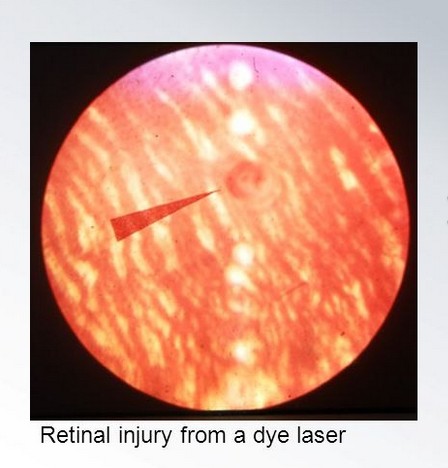
And now let's see how this happens in dynamics. Yun Sothory conducted an experiment “what will happen if you look at the laser”, using a cheap webcam as an experimental victim, and using a homemade laser based on a dye solution that was pumped by a self-made nitrogen laser as a laser. Result on video. And this is despite the fact that it has a completely non-living and oak silicon "retina". What will happen to the eyes is quite obvious.
Here is another example of the affected matrix of the camera - at 1:06 a line of scorched pixels appears at the top of the stage laser show. By the way, the safety of laser shows is a separate very holivar topic, about which a lot of copies were broken in the CIS and in the west. The power of the laser emitter before the optical system breakdown and sweep of the beam sometimes reaches tens of watts.
Let us now consider the question, are all lasers equally dangerous?
It can be concluded unambiguously that the most dangerous are lasers operating in a pulsed mode with a short pulse duration in the visible and near IR range, especially the latter. And indeed it is. However, the rules, which are usually written in a boring tone for people with low tolerance, state that all lasers, without exception, are dangerous, and any laser must be firmly enclosed, stuffed under the ground and not allowed to enter anyone. Some reservations are needed here, since everything must be within reason. Not all lasers are equally dangerous. There are those that are more dangerous, there are those that are less dangerous. This is followed by my hard IMHO, which does not claim to be true.Namely, it consists in the fact that with any laser of any wavelength, except for the near-IR range, it is possible to work without protective equipment, if it operates in continuous or quasi-continuous mode, its average power does not exceed 10-20 milliwatts, and if you do not stare into the beam. Andif you want to stare, if there is a risk of the beam falling into the eyes, for example, when visually adjusting optical systems, then the absolute upper limit of power is 0.5-1 mW, as written in the description of hazard class 2. You can satisfy your curiosity by looking for 1-2 seconds into a beam of a small helium-neon or diode laser with a power of 1 mW and understand that this is extremely unpleasant, comparable to looking at the Sun. But this is my personal experience.I would still recommend never neglecting eye protection in all cases of laser treatment. Separately among the powerful 4th class lasers are, again, copper vapor lasers, since due to the very wide beam, their energy density is small. So, for example, for my 5 W laser , the power density in a beam is 16 mW / mm2. If we assume that such a beam is accidentally hit the eye, then the damage will be comparable to that of a completely ordinary laser pointer at 100 mW, provided that the pupil diameter at this moment is about 3 mm. But these are just my assumptions, I do not advise anyone to check in practice. Eye protection when working with such a laser is absolutely necessary.
If we again refer to the wavelength dependence damage table shown at the beginning of the article, one might get the impression that lasers with radiation outside the visible and near-IR ranges do not need protection because the radiation will not reach the retina, because the eye media are opaque at lengths waves shorter than 400 nm and longer than 3 microns. This is partly correct. Indeed, the retina will not suffer, since radiation with a wavelength of more than 3 μm is absorbed by the tear film, and at low powers / energies this is not dangerous. That is why low-power laser sources like laser range finders just translate into a wavelength of about 3 microns (erbium lasers). On the other hand, there is a serious risk of burning the cornea if the power is sufficient. When exposed to high-power UV radiation, damage occurs mainly through a photochemical mechanism, and in the case of far infrared, it is thermal. But power is needed more, by orders of magnitude greater than for lasers of the visible range. Figuratively speaking, lasers can be compared with different types of snakes, among which are poisonous, killing with one short bite, and boas, killing with the help of large and brute force for a long time and tediously until the victim suffocates. Lasers from the invisible UV and far infrared ranges can be compared precisely with boas, since their power is the very “brute force”, especially for CO2 lasers emitting hundreds and thousands of watts at a wavelength of 10.6 microns. Here is an example of corneal burns from a CO2 laser. those who kill with one short bite, and boas that kill with the help of large and brute force are long and tedious, until the victim suffocates. Lasers from the invisible UV and far infrared ranges can be compared precisely with boas, since their power is the very “brute force”, especially for CO2 lasers emitting hundreds and thousands of watts at a wavelength of 10.6 microns. Here is an example of corneal burns from a CO2 laser. those who kill with one short bite, and boas that kill with the help of large and brute force are long and tedious, until the victim suffocates. Lasers from the invisible UV and far infrared ranges can be compared precisely with boas, since their power is the very “brute force”, especially for CO2 lasers emitting hundreds and thousands of watts at a wavelength of 10.6 microns. Here is an example of corneal burns from a CO2 laser.
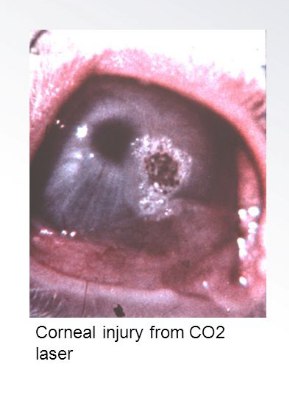
With the question of "who is to blame," figured out, now turn to the question of "what to do." Or, what protection measures should be chosen when working with laser radiation. The main measure of protection from laser radiation is primarily the enclosure of the path of the beam, limiting its spread by scavengers at the end of the optical path. If the fence can not be organized - then eye goggles are necessary. Better when both protection measures complement each other. However, universal safety glasses do not exist, except, perhaps, such. Therefore, before choosing glasses you need to know exactly which lasers to deal with.
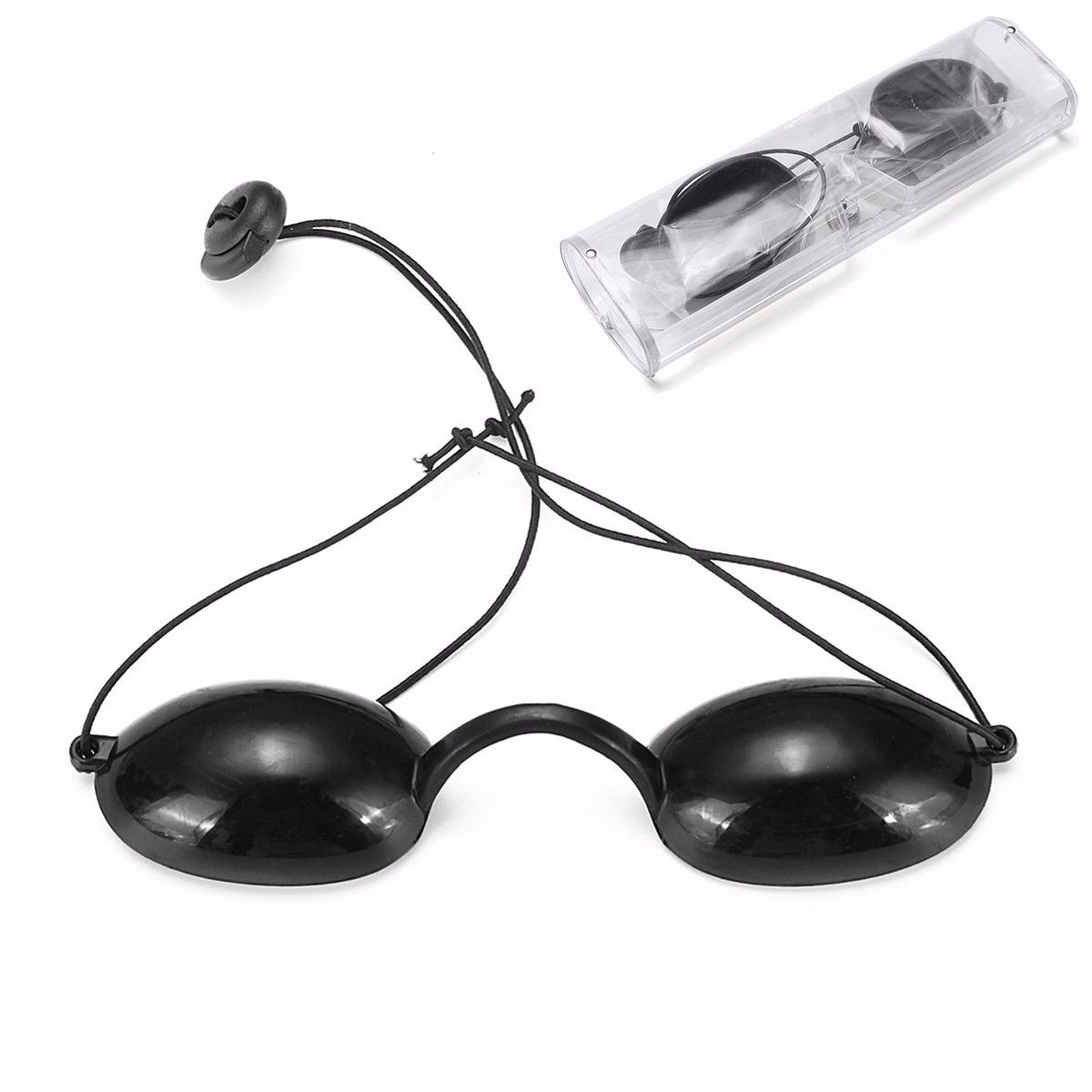
All goggles are designed to protect against specific wavelengths emitted by lasers, and for good glasses, the optical density is always normalized at each wavelength. Optical density is the coefficient of attenuation of points; in English-language standards, it is called OD-X, where X is a number indicating the number of orders of attenuation. Thus, for example, OD-6 means that glasses weaken radiation by 6 orders of magnitude, i.e. at 1,000,000 times at a given wavelength. The attenuation of 1000 times will be referred to as OD-3 and so on. Good glasses always have instructions for them, in which it is written from which wavelengths of radiation they protect, and which OD for each wavelength. Also, good glasses always have a closed design and fit snugly to the face, so that glare from radiation cannot pass under the glasses, bypassing the filters. Here are examples of really GOOD points. For example, Soviet ZND-4-72 — SZS22 — OS23—1, which I use. This is an example of an attempt to make more or less universal glasses, designed to work with common types of lasers. To do this, they have two types of filters. Glasses are made of soft rubber, well-fitting to the face, and have instructions.
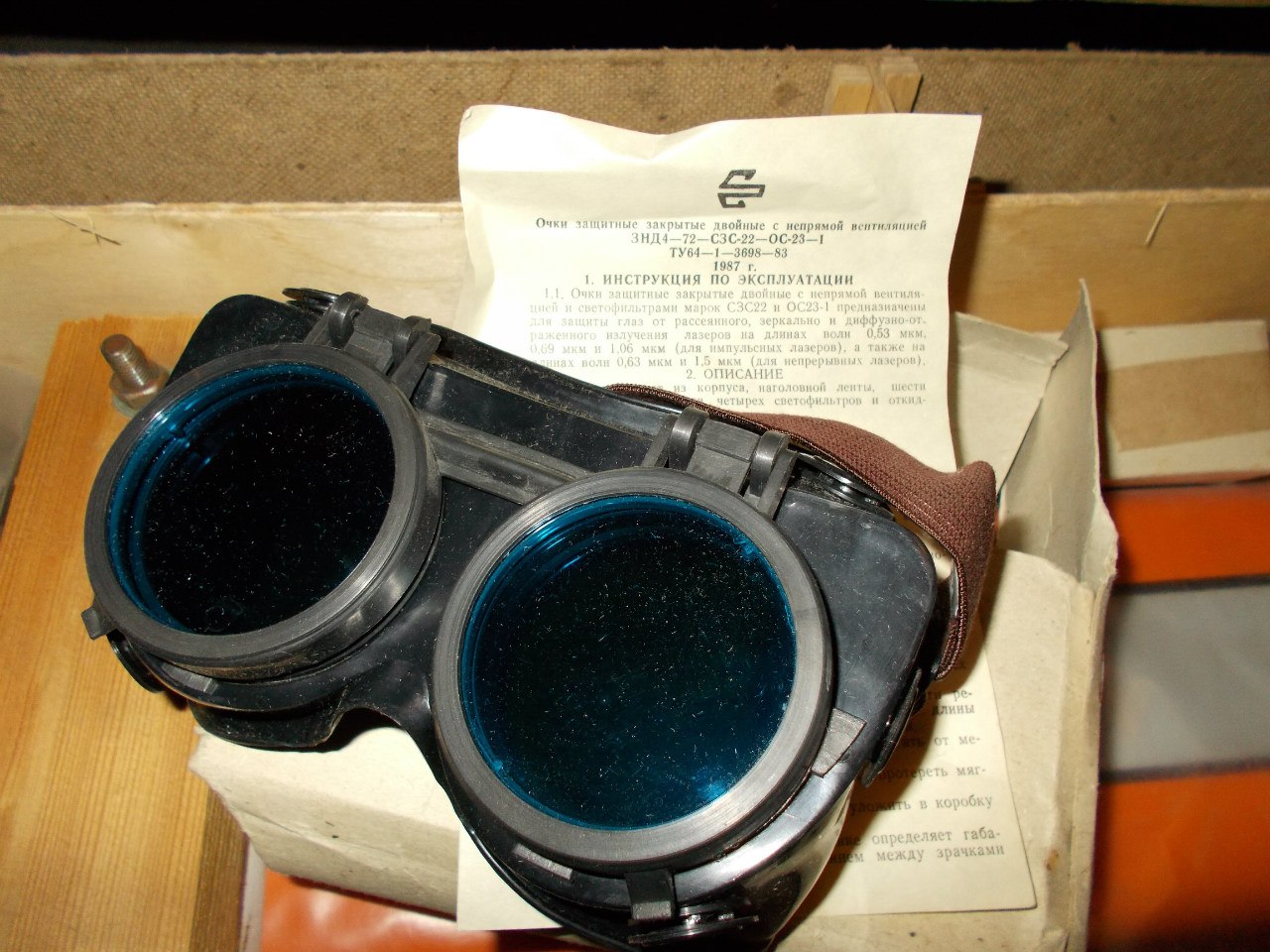
Blue light filters are designed to protect against lasers operating at a wavelength of 0.69 microns and 1.06 microns (ruby and neodymium lasers). OD-6 density is guaranteed at these wavelengths. The same filters provide protection from radiation in the 630-680 nm wavelength range (helium-neon, krypton lasers) and in the 1.2-1.4 μm range, and OD-3 is stated for them. Orange filters provide protection against wavelengths in the range from 400 to 530 nm (blue and green lasers) with OD-6 and also in the range 1.2-1.4 µm with OD-3. Orange filters by themselves cannot provide any protection against the radiation of red lasers — they require blue filters. For convenience, blue filters are made reclining.

I always use these glasses when working with all of my powerful lasers, and they can guarantee protection, subject to the instructions. Unfortunately, they have a gap for yellow lasers, i.e. They do not provide guaranteed protection instructions and, therefore, do not possess complete universality. These glasses have a modern analogue for sale, but it is less versatile, since it does not have orange filters.

Here is another example of GOOD foreign-made glasses. They have a solid rectangular glass, not obstructing the review, and the text with the parameters for wavelengths and OD on them is cast directly on the glasses body.


Now let's look at no examples of bad points, which I categorically do not recommend. This is all that plastic Chinese slag sold on aliexpress for 1-2-10 dollars. These glasses have neither full adherence to the face, nor instructions with the declared optical density at different wavelengths, nor certificates, nothing. And they are made of a rather delicate plastic. Are you ready to entrust the safety of your eyes to some nameless Chinese working for a bowl of rice? I am not ready. Do not buy Chinese slag, shown below.
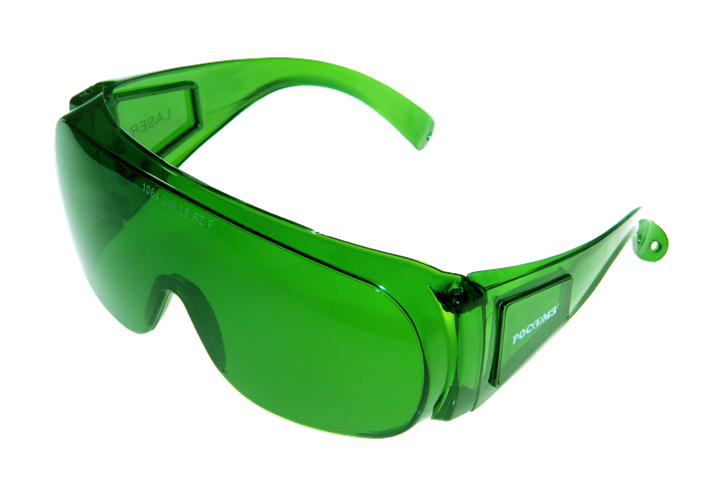
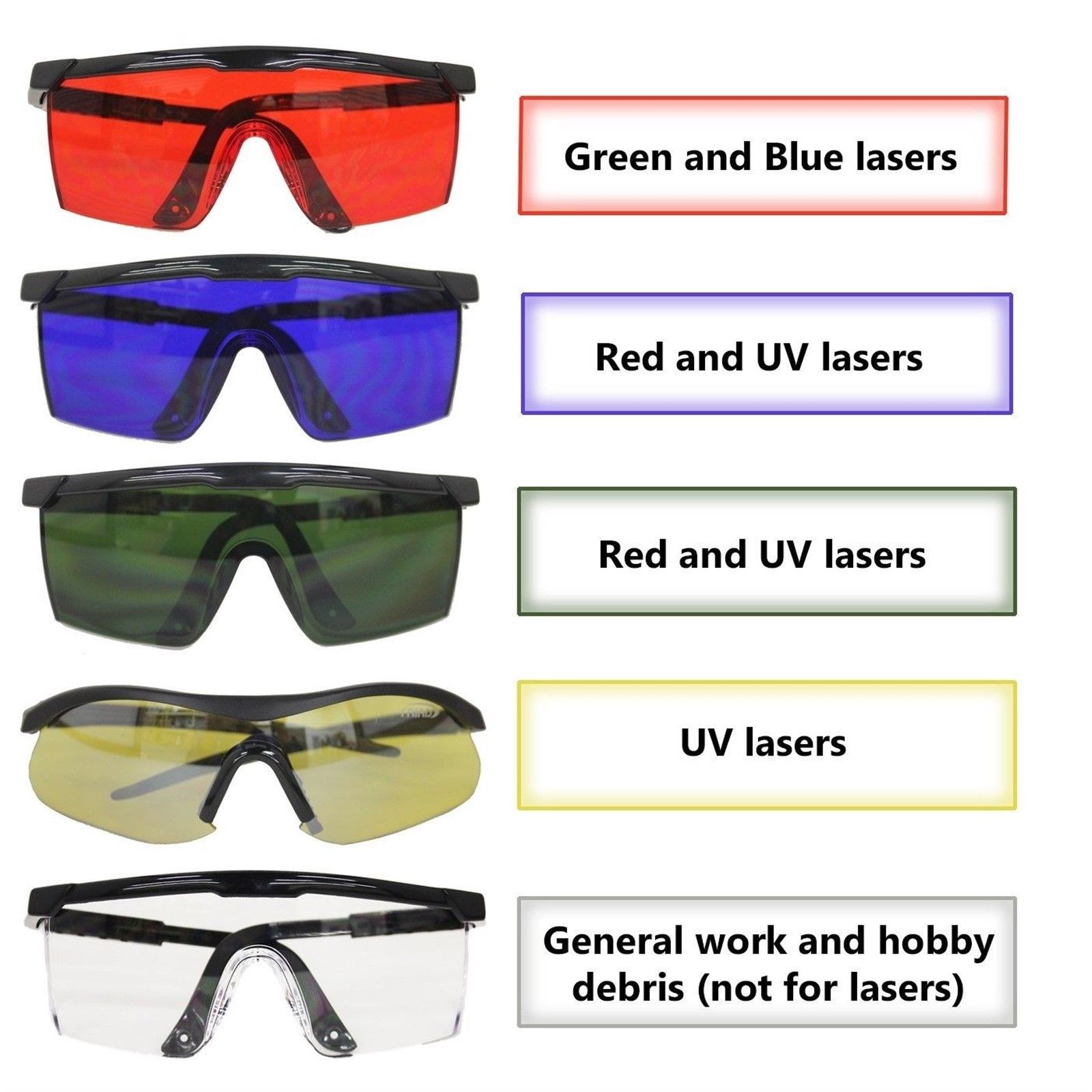
The only exception is CO2 lasers. Their radiation, generally speaking, "thermal" - the wavelength is too long, and does not even pass through a simple transparent glass and through a simple transparent plastic. Those. The GOOD glasses shown above are also suitable for protection against CO2 lasers. The BAD glasses shown here will also provide sufficient protection against scattered CO2 laser radiation, but no more. I would still recommend glass, since the direct beam of such a laser will simply burn plastic.
Separately, I would like to dwell on the security measures to which manufacturers of laser technological installations resort. In principle, if there is a CO2 laser on our laser machine, then the protection completely covering the processing field is not necessary at small power levels, such as up to 50 W. And so enough fencing of ordinary glass or plastic. In principle, even on laser machines with a CO2 laser with a power of many kilowatts, it is not always possible to meet the fence from scattered radiation, since it does not pose a great danger, since this radiation is thermal and is perceived simply as heat flow when you look at the open spiral of a hot plate or Infrared heater. Feels discomfort - and you can go away. The lack of protection on machines with CO2 lasers is quite acceptable. But it is strictly forbidden on installations with a wide distribution of fiber lasers! The fiber laser operates at a wavelength of about 1 μm, which, as mentioned above, easily reaches the retina, at power levels already in units of watts, the scattered radiation is very dangerous for the eyes, and for such laser installations, the protection of the working field with blocking is MANDATORY Here is an example where this is done correctly. The entire working area of these cutting machines is covered with glass that does not transmit diffuse radiation. !! Here is an example where this is done correctly. The entire working area of these cutting machines is covered with glass that does not transmit diffuse radiation. !! Here is an example where this is done correctly. The entire working area of these cutting machines is covered with glass that does not transmit diffuse radiation.
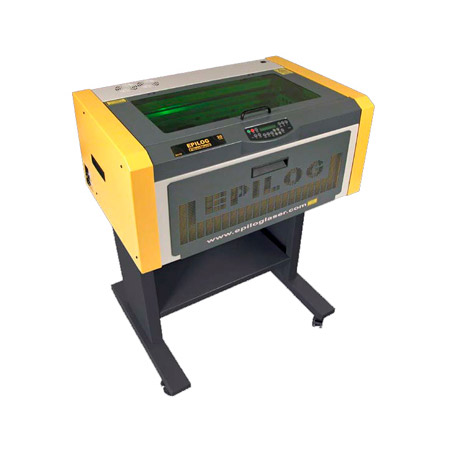

Laser markers, engravers must also necessarily have a closed field, since this is also either fiber lasers or neodymium lasers operating in the Q-switching mode, very dangerous for the eyes. An example of how this should be correct.

And now, a graphic picture of how the Chinese relate to our health. For such a performance of a laser engraver, you need to hit the head with a stick, write out a multi-million fine and deny the right to produce these machines. After all, the buyer, having seen such a machine without protection of the working field, decides that it is not needed, since the manufacturer has not installed it. When working, all the scattered and reflected radiation, especially during engraving on metal, will fly straight into his eyes. Unless of course he wore glasses. And I'm not sure that he will wear them. And if he gets retinal damage when working with such a machine, he will have the full right to file a lawsuit against the manufacturer and easily win it by slup a large amount of money.
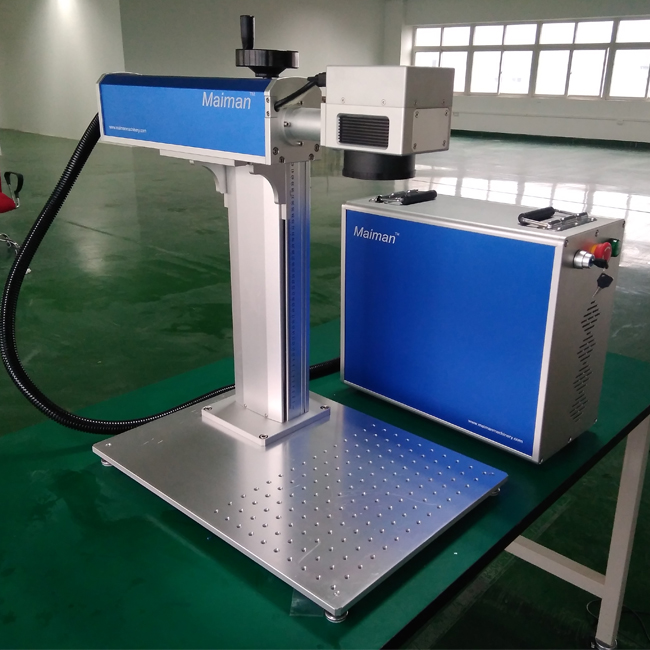
So, do not buy Chinese slag, use the correct means of protection and do not look into the beam with the remaining eye!
When writing this article, materials were used from the following sources, in addition to the bottomless depths of the Internet:
1. Grankin V. Ya. Laser radiation, 1977
2. www.repairfaq.org/sam/laserfaq.htm
3. www.laserkids.sourceforge.net
ATTENTION: This article may contain errors and inaccuracies, since I am not an expert in medical matters.

As is known, the main property of a laser is a very high directivity and monochromaticity of radiation, a significant power of the light flux is concentrated in a very thin beam. In turn, each of us is equipped with a very sensitive apparatus for the perception of light — with our eyes. The eyes, on the contrary, are designed to use the smallest levels of light intensity to provide their host with the necessary visual information. It is already becoming clear that the combination of a highly concentrated and powerful light beam with a sensitive visual organ is already poorly compatible, respectively, such a beam will be dangerous. This, in general, is obvious, if one cannot look at the Sun for more than a few seconds, then into a beam of a powerful laser that burns holes in paper — even more so. But not everything is so simple. The danger of laser radiation strongly depends on its nature (pulsed or continuous), power, wavelength. Also, very many installations based on gas or solid-state / liquid lamp-pumped lasers contain circuits and high-voltage components — transformers, radio tubes, switching arresters and thyratrons, powerful capacitors, which are a source of electrical danger. But I will not focus on them, a lot of literature has been written about electrical safety, and this is a topic that has become a bit tattered among testers. Here I will confine myself only to the consideration of the danger of optical only - which is directly transmitted by laser radiation. Also, very many installations based on gas or solid-state / liquid lamp-pumped lasers contain circuits and high-voltage components — transformers, radio tubes, switching arresters and thyratrons, powerful capacitors, which are a source of electrical danger. But I will not focus on them, a lot of literature has been written about electrical safety, and this is a topic that has become a bit tattered among testers. Here I will confine myself only to the consideration of the danger of optical only - which is directly transmitted by laser radiation. Also, very many installations based on gas or solid-state / liquid lamp-pumped lasers contain circuits and high-voltage components — transformers, radio tubes, switching arresters and thyratrons, powerful capacitors, which are a source of electrical danger. But I will not focus on them, a lot of literature has been written about electrical safety, and this is a topic that has become a bit tattered among testers. Here I will confine myself only to the consideration of the danger of optical only - which is directly transmitted by laser radiation. A lot of literature has been written about electrical safety, and this is a scathing topic among tesast builders. Here I will confine myself only to the consideration of the danger of optical only - which is directly transmitted by laser radiation. A lot of literature has been written about electrical safety, and this is a scathing topic among tesast builders. Here I will confine myself only to the consideration of the danger of optical only - which is directly transmitted by laser radiation.
When varying the parameters of the laser will also vary the mechanisms of damage to the eyes, which are described in detail in the specialized literature. The effects of laser radiation, regardless of its power, are described in the picture:

This data should not be taken as the ultimate truth, it is only the version of one of the books. The described effects can be combined in any ratios, depending on the other parameters - power and wavelength. Strictly speaking, the pulsed mode of the laser can be divided into two more - a pulsed mode of free generation and a pulsed mode with Q-switched. In the second case, the laser translates into so-called. “Giant pulse mode”, when all the energy accumulated during pumping from the working medium is emitted by a short (few tens of nanoseconds) pulse. The power per pulse at the same time reaches many tens and hundreds of megawatts with modest sub-joule energies. When exposed to a "giant impulse", the damage has primarily an explosive mechanism, since the heat generated by absorption cannot go anywhere in such a short time. Under the action of a pulse of free generation, damage proceeds more by a thermal mechanism, since heat partially discharges and disperses in the thickness of the absorbing layer, since the pulse has a lower peak power due to a relatively long duration (milliseconds).
Particularly characteristic is the role of wavelength, since the transparency of ocular media is not the same for different wavelengths. As a departure from the topic, I note that for X-ray or gamma radiation, it is considered that the biological effect does not depend on the wavelength, only the penetrating ability changes. And in general, in the specialized literature on issues of protection from X-rays are delayed only a few pages, while issues related to safety when working with laser radiation can devote entire sections. But back to the dependence of the effects of wavelength. Here we turn to another table from the same book. It describes the damage mechanisms depending on the wavelength, again without regard to power.

It is clear that the most obvious will be the danger of radiation of the visible range, since it is this that reaches the retina and is perceived by it. But if it is obvious - this does not mean that the most dangerous. The fact of the matter is that the beam of the visible range can be seen, and the blink reflex of the eye in this case works flawlessly, in some cases it can greatly reduce damage. While the beam from the near infrared range is already impossible to notice, but it also reaches the retina and there is no blink reflex. It is the retina that is the most sensitive part of the eye to damage, and most sadly - incapable of regeneration.
Thus, if the radiation mode and wavelength are known, the last, in fact, decisive factor remains - this is the radiation power. It is she who decides if your eyes burn under the beam completely, partially or not at all. Depending on the wavelength, only the magnitude of this power changes, if the beam is continuous, or the pulse energy, if the beam is pulsed.
It was by the radiation power that the separation of lasers into existing hazard classes was adopted. Consider them in more detail, looking at the site Sam's Laser FAQ. For convenience, a Russian translation from English is provided by moderator of the forum laserforum.ru Gall. And whoever finds a mistake in the picture is a good fellow.

So, danger classes.
Quote:
• Class I laser products
There are no known biological threats. The radiation is closed from any possible viewing by a person, and the laser system has interlocks that do not allow the laser to be turned on in the open state. (Large laser printers, such as the DEC LPS-40, operate on 10 mW helium-neon lasers, which are class IIIb lasers, but the printer has interlocks to prevent any contact with the open laser beam, so the device does not present a biological hazard, although the laser itself belongs to class IIIb. This also applies to CD / DVD / Blu-ray players and small laser printers, as they are laser products of class I).
• Class II laser products
Output power up to 1 mW. Such lasers are not considered optically dangerous devices, as eye reflexes prevent any damage occurring. (For example, when a bright light enters the eye, the eyelid blinks automatically or the person turns his head so that the bright light disappears. This is called a reflex action or reaction time. Class II lasers do not cause damage to the eye during this time. Also, nobody wants to look at it for a longer time.) Warning signs (yellow) should be placed on the laser equipment. There are no known skin exposure hazards and no fire hazard.
• Class IIIa laser products
Output power from 1 mW to 5 mW. Such lasers can cause partial blindness under certain conditions and other eye damage. Products containing a class IIIb laser should have a laser indicator that indicates when the laser is operating. They must also have a “Danger” sign and a sign indicating the laser exit hole mounted on the laser and / or equipment. SHOULD install the power switch in the form of a key lock to prevent unauthorized use. There are no known skin and fire hazards.
• Laser products class IIIb
Output power from 5 mW to 500 mW. Such lasers are considered definitely a threat to vision, especially at high power, which WILL DAMAGE your eyes. Such lasers MUST have a key lock against unauthorized use, an indicator of the presence of laser radiation, a switch-on delay of 3 to 5 seconds after power is applied so that the operator can get out of the way of the beam, and a mechanical shutter that allows the beam to be blocked during use. The skin can be burned at high output power levels, and a short-term direction to some materials can lead to fire. (I saw a 250 mW argon laser igniting a piece of red paper in less than 2 seconds of exposure!) The red “DANGER” sign and the exit sign should MUST be placed on the laser.
• Class IV laser products.
Output power> 500 mW. These lasers MAY damage and damage the eyes. Capacity level IV class may ignite and ignite combustible materials in contact with, including burn skin and burn through clothing. Such laser products MUST have: A
key lock to prevent unauthorized use, locks to prevent the system from being used with covers removed, radiation indicators indicating that the laser is working, mechanical shutters to block the beam, and red "DANGER" ("DANGER") and The signs of the outlet, mounted on the laser.
The reflected beam must be considered as dangerous as the original beam. (And again, I saw a 1000 watt CO2 laser burning a hole in steel, so imagine what it would do to your eye!)
End of quote.
Note: Yes, my lasers are mainly classified as 4th hazard class, and do not contain many hardware protection measures, since only I deal with them. Therefore, I ask to refrain in the comments from the questions why there is no lock switch or covers with interlocks on my lasers. These requirements are primarily for commercially available installations.
Now let's see, so to speak, visually how an eye injury looks like by laser radiation. I have already mentioned that in search of new lasers and their components I visit various organizations. And once I visited the laser department of the local center for the treatment of eye diseases. In the course of communication with specialists, I wondered if there were injuries in their practice caused by laser radiation. The answer surprised me. The fact is that for more than 20 years of practice, laser injuries were only a few pieces. To my question, like so, if now every child has a laser pointer from 50 to 2000 mW, they only answered that there were no people with burns from the pointer. But there were a lot of people with solar, non-laser, burns of the retina. I was shown documents on the most remarkable laser injury - severe damage to the central fossa of the retina caused by a specularly reflected pulse from a laser rangefinder, built on a pulsed neodymium laser (Nd: YAG) working in the Q-switching mode. The pulse energy was, according to various estimates, from 20 to 100 mJ, with a pulse duration of the order of 20 ns. It was because of the modulation of the Q-factor that the damage was so severe - because at the focal point of the radiation there was an optical breakdown that caused a water hammer, which in turn led to a central retinal break and swelling of the latter together with hemophthalmia (vitreous hemorrhage). I was allowed to scan documents on the terms of their complete anonymization. Using optical coherent tomography, you can examine the retina in section, in different planes. It looked like a cut at the time of seeking medical assistance. There is a clear “hole” with the edges “bent outward” (in fact, it is edema).

A larger plan:

And in different planes:

From the text of the documents provided to me, it became known that the course of treatment lasted 10 days, during which the question of the operation was decided, in case of retinal detachment. As a surgical intervention to eliminate a possible detachment and close the gap, pneumoretinopathy was suggested. Conservative treatment was aimed at resolving the edema and preventing the inflammatory process. In the course of the observation, several fundus photos were also taken, and at the end of the course, it was decided that the operation would not be necessary, since the gap closed on its own and was overgrown with scar tissue.
Photos of the fundus are placed in chronological order.

In a handful of the same documents lay another printout of optical coherence tomography after the end of treatment.


As you can see, the breakdown channel disappeared, and the edges of that place, which was the central fossa, took on smoother shapes. At the time of injury, the visual acuity on the table. Sivtseva was 0%, after the end of treatment, an improvement of up to 30% was achieved. To my question of how it is perceived subjectively, I was shown another picture, which clearly shows what a “central scotoma” is. This is a blind spot, from which just part of the image falls. The brain is able to “paint over” it to the color of the surrounding background, but no image details will be visible, since there is nothing to see - the light-sensitive cells in this place are destroyed. For this article, the picture is taken from Google. I was also told that in the presence of a second healthy eye, this blind spot does not affect the quality of life.

Later, I managed to unearth another table with comparative clinical data, where the outcomes of laser injuries are considered depending on the type of laser and its mode of operation. As you can see, the most unfavorable outcomes are in the case of injuries from lasers operating in the modulated Q mode, since retinal damage proceeded by an explosive mechanism, while a laser pulse in the free generation mode only leads to a thermal burn, which is reversible, not to some extent. looking at much higher radiation energy. Strictly speaking, damage localization plays a larger role than laser parameters; damage to the central fossa is irreversible in all cases.

Here is another example of a fundus photograph with a laser burn of the retina caused by a dye laser pulse. Dye lasers are comparable to pulsed lasers with Q-switching in terms of pulse duration and energy.

And now let's see how this happens in dynamics. Yun Sothory conducted an experiment “what will happen if you look at the laser”, using a cheap webcam as an experimental victim, and using a homemade laser based on a dye solution that was pumped by a self-made nitrogen laser as a laser. Result on video. And this is despite the fact that it has a completely non-living and oak silicon "retina". What will happen to the eyes is quite obvious.
Here is another example of the affected matrix of the camera - at 1:06 a line of scorched pixels appears at the top of the stage laser show. By the way, the safety of laser shows is a separate very holivar topic, about which a lot of copies were broken in the CIS and in the west. The power of the laser emitter before the optical system breakdown and sweep of the beam sometimes reaches tens of watts.
Let us now consider the question, are all lasers equally dangerous?
It can be concluded unambiguously that the most dangerous are lasers operating in a pulsed mode with a short pulse duration in the visible and near IR range, especially the latter. And indeed it is. However, the rules, which are usually written in a boring tone for people with low tolerance, state that all lasers, without exception, are dangerous, and any laser must be firmly enclosed, stuffed under the ground and not allowed to enter anyone. Some reservations are needed here, since everything must be within reason. Not all lasers are equally dangerous. There are those that are more dangerous, there are those that are less dangerous. This is followed by my hard IMHO, which does not claim to be true.Namely, it consists in the fact that with any laser of any wavelength, except for the near-IR range, it is possible to work without protective equipment, if it operates in continuous or quasi-continuous mode, its average power does not exceed 10-20 milliwatts, and if you do not stare into the beam. And
If we again refer to the wavelength dependence damage table shown at the beginning of the article, one might get the impression that lasers with radiation outside the visible and near-IR ranges do not need protection because the radiation will not reach the retina, because the eye media are opaque at lengths waves shorter than 400 nm and longer than 3 microns. This is partly correct. Indeed, the retina will not suffer, since radiation with a wavelength of more than 3 μm is absorbed by the tear film, and at low powers / energies this is not dangerous. That is why low-power laser sources like laser range finders just translate into a wavelength of about 3 microns (erbium lasers). On the other hand, there is a serious risk of burning the cornea if the power is sufficient. When exposed to high-power UV radiation, damage occurs mainly through a photochemical mechanism, and in the case of far infrared, it is thermal. But power is needed more, by orders of magnitude greater than for lasers of the visible range. Figuratively speaking, lasers can be compared with different types of snakes, among which are poisonous, killing with one short bite, and boas, killing with the help of large and brute force for a long time and tediously until the victim suffocates. Lasers from the invisible UV and far infrared ranges can be compared precisely with boas, since their power is the very “brute force”, especially for CO2 lasers emitting hundreds and thousands of watts at a wavelength of 10.6 microns. Here is an example of corneal burns from a CO2 laser. those who kill with one short bite, and boas that kill with the help of large and brute force are long and tedious, until the victim suffocates. Lasers from the invisible UV and far infrared ranges can be compared precisely with boas, since their power is the very “brute force”, especially for CO2 lasers emitting hundreds and thousands of watts at a wavelength of 10.6 microns. Here is an example of corneal burns from a CO2 laser. those who kill with one short bite, and boas that kill with the help of large and brute force are long and tedious, until the victim suffocates. Lasers from the invisible UV and far infrared ranges can be compared precisely with boas, since their power is the very “brute force”, especially for CO2 lasers emitting hundreds and thousands of watts at a wavelength of 10.6 microns. Here is an example of corneal burns from a CO2 laser.

With the question of "who is to blame," figured out, now turn to the question of "what to do." Or, what protection measures should be chosen when working with laser radiation. The main measure of protection from laser radiation is primarily the enclosure of the path of the beam, limiting its spread by scavengers at the end of the optical path. If the fence can not be organized - then eye goggles are necessary. Better when both protection measures complement each other. However, universal safety glasses do not exist, except, perhaps, such. Therefore, before choosing glasses you need to know exactly which lasers to deal with.

All goggles are designed to protect against specific wavelengths emitted by lasers, and for good glasses, the optical density is always normalized at each wavelength. Optical density is the coefficient of attenuation of points; in English-language standards, it is called OD-X, where X is a number indicating the number of orders of attenuation. Thus, for example, OD-6 means that glasses weaken radiation by 6 orders of magnitude, i.e. at 1,000,000 times at a given wavelength. The attenuation of 1000 times will be referred to as OD-3 and so on. Good glasses always have instructions for them, in which it is written from which wavelengths of radiation they protect, and which OD for each wavelength. Also, good glasses always have a closed design and fit snugly to the face, so that glare from radiation cannot pass under the glasses, bypassing the filters. Here are examples of really GOOD points. For example, Soviet ZND-4-72 — SZS22 — OS23—1, which I use. This is an example of an attempt to make more or less universal glasses, designed to work with common types of lasers. To do this, they have two types of filters. Glasses are made of soft rubber, well-fitting to the face, and have instructions.

Blue light filters are designed to protect against lasers operating at a wavelength of 0.69 microns and 1.06 microns (ruby and neodymium lasers). OD-6 density is guaranteed at these wavelengths. The same filters provide protection from radiation in the 630-680 nm wavelength range (helium-neon, krypton lasers) and in the 1.2-1.4 μm range, and OD-3 is stated for them. Orange filters provide protection against wavelengths in the range from 400 to 530 nm (blue and green lasers) with OD-6 and also in the range 1.2-1.4 µm with OD-3. Orange filters by themselves cannot provide any protection against the radiation of red lasers — they require blue filters. For convenience, blue filters are made reclining.

I always use these glasses when working with all of my powerful lasers, and they can guarantee protection, subject to the instructions. Unfortunately, they have a gap for yellow lasers, i.e. They do not provide guaranteed protection instructions and, therefore, do not possess complete universality. These glasses have a modern analogue for sale, but it is less versatile, since it does not have orange filters.

Here is another example of GOOD foreign-made glasses. They have a solid rectangular glass, not obstructing the review, and the text with the parameters for wavelengths and OD on them is cast directly on the glasses body.


Now let's look at no examples of bad points, which I categorically do not recommend. This is all that plastic Chinese slag sold on aliexpress for 1-2-10 dollars. These glasses have neither full adherence to the face, nor instructions with the declared optical density at different wavelengths, nor certificates, nothing. And they are made of a rather delicate plastic. Are you ready to entrust the safety of your eyes to some nameless Chinese working for a bowl of rice? I am not ready. Do not buy Chinese slag, shown below.


The only exception is CO2 lasers. Their radiation, generally speaking, "thermal" - the wavelength is too long, and does not even pass through a simple transparent glass and through a simple transparent plastic. Those. The GOOD glasses shown above are also suitable for protection against CO2 lasers. The BAD glasses shown here will also provide sufficient protection against scattered CO2 laser radiation, but no more. I would still recommend glass, since the direct beam of such a laser will simply burn plastic.
Separately, I would like to dwell on the security measures to which manufacturers of laser technological installations resort. In principle, if there is a CO2 laser on our laser machine, then the protection completely covering the processing field is not necessary at small power levels, such as up to 50 W. And so enough fencing of ordinary glass or plastic. In principle, even on laser machines with a CO2 laser with a power of many kilowatts, it is not always possible to meet the fence from scattered radiation, since it does not pose a great danger, since this radiation is thermal and is perceived simply as heat flow when you look at the open spiral of a hot plate or Infrared heater. Feels discomfort - and you can go away. The lack of protection on machines with CO2 lasers is quite acceptable. But it is strictly forbidden on installations with a wide distribution of fiber lasers! The fiber laser operates at a wavelength of about 1 μm, which, as mentioned above, easily reaches the retina, at power levels already in units of watts, the scattered radiation is very dangerous for the eyes, and for such laser installations, the protection of the working field with blocking is MANDATORY Here is an example where this is done correctly. The entire working area of these cutting machines is covered with glass that does not transmit diffuse radiation. !! Here is an example where this is done correctly. The entire working area of these cutting machines is covered with glass that does not transmit diffuse radiation. !! Here is an example where this is done correctly. The entire working area of these cutting machines is covered with glass that does not transmit diffuse radiation.


Laser markers, engravers must also necessarily have a closed field, since this is also either fiber lasers or neodymium lasers operating in the Q-switching mode, very dangerous for the eyes. An example of how this should be correct.

And now, a graphic picture of how the Chinese relate to our health. For such a performance of a laser engraver, you need to hit the head with a stick, write out a multi-million fine and deny the right to produce these machines. After all, the buyer, having seen such a machine without protection of the working field, decides that it is not needed, since the manufacturer has not installed it. When working, all the scattered and reflected radiation, especially during engraving on metal, will fly straight into his eyes. Unless of course he wore glasses. And I'm not sure that he will wear them. And if he gets retinal damage when working with such a machine, he will have the full right to file a lawsuit against the manufacturer and easily win it by slup a large amount of money.

So, do not buy Chinese slag, use the correct means of protection and do not look into the beam with the remaining eye!
When writing this article, materials were used from the following sources, in addition to the bottomless depths of the Internet:
1. Grankin V. Ya. Laser radiation, 1977
2. www.repairfaq.org/sam/laserfaq.htm
3. www.laserkids.sourceforge.net
